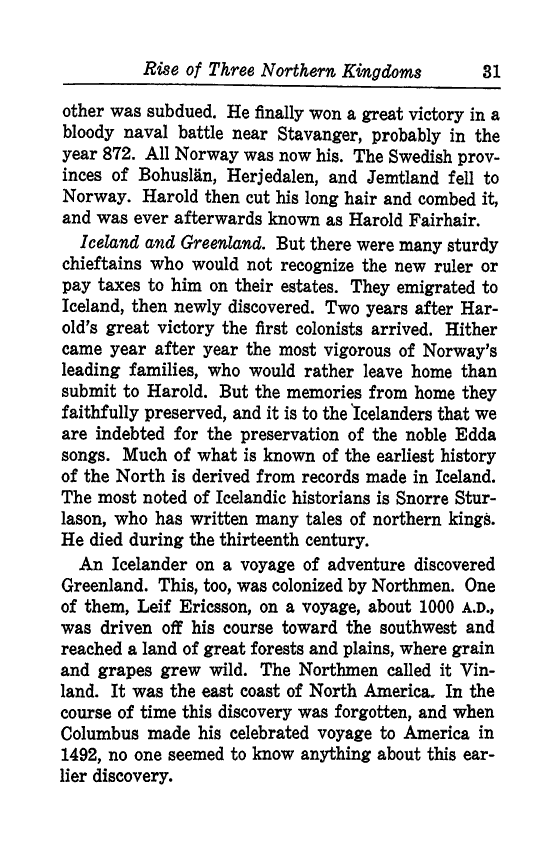
Full resolution (TIFF) - On this page / på denna sida - II. The North during the Ninth Century - F. Rise of the Three Northern Kingdoms

<< prev. page << föreg. sida << >> nästa sida >> next page >>
Below is the raw OCR text
from the above scanned image.
Do you see an error? Proofread the page now!
Här nedan syns maskintolkade texten från faksimilbilden ovan.
Ser du något fel? Korrekturläs sidan nu!
This page has never been proofread. / Denna sida har aldrig korrekturlästs.
Rise of Three Northern Kingdoms 31
other was subdued. He finally won a great victory in a
bloody naval battle near Stavanger, probably in the
year 872. All Norway was now his. The Swedish prov-
inces of Bohuslan, Herjedalen, and Jemtland fell to
Norway. Harold then cut his long hair and combed it,
and was ever afterwards known as Harold Fairhair.
Iceland and Greenland. But there were many sturdy
chieftains who would not recognize the new ruler or
pay taxes to him on their estates. They emigrated to
Iceland, then newly discovered. Two years after Har-
old’s great victory the first colonists arrived. Hither
came year after year the most vigorous of Norway’s
leading families, who would rather leave home than
submit to Harold. But the memories from home they
faithfully preserved, and it is to the Icelanders that we
are indebted for the preservation of the noble Edda
songs. Much of what is known of the earliest history
of the North is derived from records made in Iceland.
The most noted of Icelandic historians is Snorre Stur-
lason, who has written many tales of northern kings.
He died during the thirteenth century.
An Icelander on a voyage of adventure discovered
Greenland. This, too, was colonized by Northmen. One
of them, Leif Ericsson, on a voyage, about 1000 A.D.,
was driven off his course toward the southwest and
reached a land of great forests and plains, where grain
and grapes grew wild. The Northmen called it Vin-
land. It was the east coast of North America, In the
course of time this discovery was forgotten, and when
Columbus made his celebrated voyage to America in
1492, no one seemed to know anything about this ear-
lier discovery.
<< prev. page << föreg. sida << >> nästa sida >> next page >>